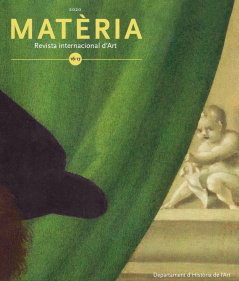Regarding the permeability of film theory: A reflection on <i> correlations </i> within the framework of the Soviet classical school
DOI:
https://doi.org/10.1344/Materia2020.16-17.10Keywords:
soviet cinema, editing, formalism, cinema theory, interval, correlation, metaphor, Eisenstein, atractionAbstract
Within the intense theoretical scene that unfolds in the post-revolutionary Soviet context, with the objective of exploring and deconstructing the gears which articulates any creative work, a cinematographic expression will build a privileged platform where the reflective domains cite literary theory and musicology, among others.
Thus, in the core of the early theorizing tradition emanating substantially from the editing practice, a passionate speculative dialogue about rhythms, metaphors and intervals is summoned. The article reveals an integrating perspective, the intimate connections that are woven within.
References
ALBERA, François, Los formalistas rusos y el cine. La poética del filme, Barcelona, Ediciones Paidós, 1979.
AUMONT, Jacques, Montage Eisenstein (Theories of Representation & Difference), Bloomington, Indiana University Press, 1987.
AUMONT, Jacques, Las teorías de los cineastas. La concepción de los grandes cineastas, Barcelona, Ediciones Paidós, 2004.
AUMONT, Jacques; MARIE, Michel, Dictionnaire théorique et critique du cinéma, Paris, Armand Colin, 2007.
BENJAMIN, Walter, Discursos interrumpidos I. Filosofía del arte y de la historia, Madrid, Ediciones Taurus, 1987.
BALÁZS, Béla, El film, evolución y esencia de un arte nuevo, Barcelona, Gustavo Gili, 1978. BURCH, Noël, El tragaluz del infinito. Contribución a la genealogía del lenguaje cinematográfico, Madrid, Editorial Cátedra, 1991.
EIKHENBAUM, Boris M (Ed.), The Poetics of Cinema, Oxford, Somerton, 1982.
EISENSTEIN, Sergei M., Teoría y técnica cinematográficas, Madrid, Ediciones Rialp, 1989.
EISENSTEIN, Sergei M., «El montaje de atracciones» (1923), ALSINA-THEVENET, Homero; ROMAGUERA I RAMIÓ, Joaquim (Eds.), Textos y manifiestos del cine. Estética. Escuelas. Movimientos. Disciplinas. Innovaciones, Madrid, Ediciones Cátedra, 1989.
IVANOV, Vladimir, «Eisenstein y la lingüística estructural moderna», URRUTIA, Jorge (Ed.), Contribuciones al análisis semiológico del film, Valencia, Fernando Torres Editor. 1976.
LAÍNEZ, Josep Carles, Contrucción metafórica y análisis fílmico, Valencia, Diputació de Valéncia/ Institució Alfons el Magnànim, 2003.
MARINIELLO, Silvestra, El cine y el fin del arte. Teoría y práctica cinematográfica en Lev Kuleshov, Madrid, Ed. Cátedra, 1992.
PIERRE, Sylvie, «Elementos para una teoría del fotograma» (1971). URRUTIA, Jorge (Ed.), Contribuciones al análisis semiológico del film, Valencia, Fernando Torres Editor, 1976.
SANGRO COLÓN, Pedro,Teoría del montaje cinematográfico: texto y textualidad, Salamanca, Publicaciones Universidad Pontificia de Salamanca/Caja Duero, 2000.
SKLOVSKI, Victor, Lenguaje y cine, Barcelona, Ed. Anagrama, 1971.
SONTAG, Susan, Sobre la fotografía, Barcelona, Edhasa, 1996.
TARKOVSKI, Andrei, Esculpir en el tiempo. Reflexiones sobre el arte, la estética y la poética del cine, Madrid, Ediciones Rialp, 1991.
TSIKOUNAS, Myriam, «Russes et Soviétiques: des conceptions différentes», CinémAction, nº 72, 1994.
TYNIANOV, Yuri, “Los fundamentos del cine” (1927), ALBERA, François, Los formalistas rusos y el cine. La poética del filme, Barcelona, Ediciones Paidós, 1979.
VERTOV, Vertov, «From Kino-Eye to radio-Eye» (1929), MICHELSON, Annette (Ed.), Kino-Eye. The Writings of Dziga Vertov, Berkeley, University of California Press, 1984.
Downloads
Published
Issue
Section
License
The authors who publish in this journal agree to the following terms:
|  |







